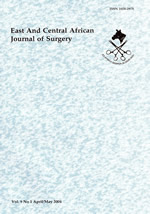
|
East and Central African Journal of Surgery
Association of Surgeons of East Africa and College of Surgeons of East Central and Southern Africa
ISSN: 1024-297X
EISSN: 1024-297X
Vol. 16, No. 3, 2011, pp. 86-93
|
 Bioline Code: js11056
Bioline Code: js11056
Full paper language: English
Document type: Research Article
Document available free of charge
|
|
|
East and Central African Journal of Surgery, Vol. 16, No. 3, 2011, pp. 86-93
| en |
Blood and body fluid exposures among surgeons in Mulago hospital
Kimuli, T.; Meya, Denise; Meya, David; Tulsky, J. & Schecter, W.
Abstract
Background:
It is now recognized that health workers are at risk of acquiring infection with hepatitis B virus (HBV), hepatitis C virus (HCV), HIV and other blood borne pathogens through contact with infected blood and other body fluids. This study was aimed at determining the frequency and circumstances of blood borne pathogen exposures among operating theatre personnel in Mulago Hospital.
Methods:
We surveyed operating room personnel in the hospital including surgeons, surgical trainees (senior house officers, interns and medical students) and theatre nurses. Survey forms were distributed to operating room personnel at their various stations in July 2008 in Mulago Hospital. Information relating to the study was provided at departmental meetings (in surgery, orthopedic and obstetrics and gynecology) that encouraged operating room personnel to complete and return the survey forms. The forms were collected after completion.
Results:
During the previous year operating room personnel sustained a mean of 3.2 (95% CI 2.5-3.9) percutaneous injuries per operating theatre personnel per year. Exposures to blood and body fluids were predominantly from blood splashing into the eyes. Fewer than half of the respondents reported completion of hepatitis B vaccination, and post exposure prophylaxis for human immunodeficiency virus was widely available to over 79% of respondents though used much less, only 24% of injured respondents with access to PEP. Half (50%) of Surgeons reported using hands free passing technique and 27% reported use of blunt suture needles. Non-fluid resistant cotton gowns and masks were the barriers worn most frequently.
|
| |
© Copyright 2011 - East and Central African Journal of Surgery
|
|
